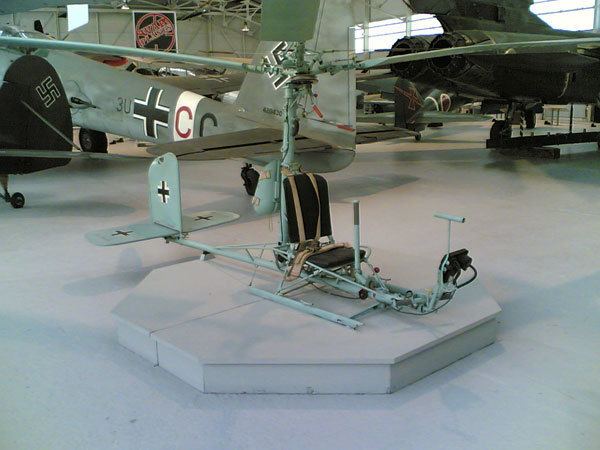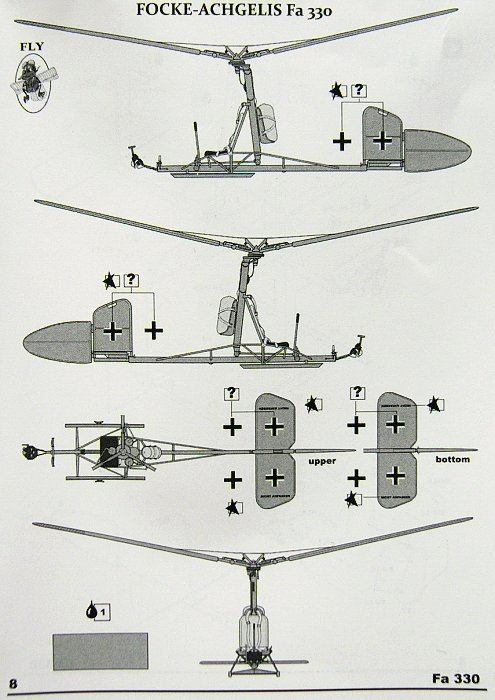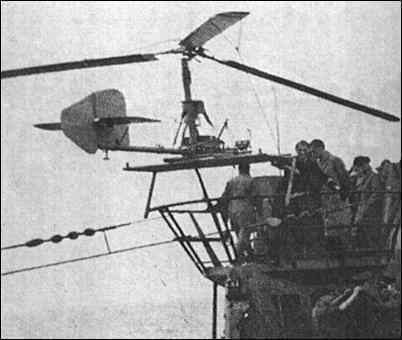Top speed 40 km/h | Length 4.42 m | |
 | ||
The Focke-Achgelis Fa 330 Bachstelze (English: Wagtail) was a type of rotary-wing kite, known as a gyroglider or rotor kite. They were towed behind German U-boats during World War II to allow a lookout to see farther.
Contents
- Development
- Operational history
- Legacy and influence
- Denmark
- France
- Germany
- United Kingdom
- United States
- Specifications
- References

Development

Because of their low profile in the water, submarines could not see more than a few miles over the ocean. To solve this, the German admiralty considered a number of different options, including a folding seaplane (Arado Ar 231). In the end, they chose the Fa 330, a simple, single-seater, autogyro kite with a three-bladed rotor.

The Fa 330 could be deployed to the deck of the submarine by two people and was tethered to the U-boat by a 150 m (500 ft) cable. The airflow on the rotors as the boat motored along on the surface would spin them up. The kite would then be deployed behind the U-boat with its observer-pilot aboard, raising him approximately 120 meters above the surface and allowing him to see much farther — about 25 nautical miles (46 km), compared to the 5 nautical miles (9 km) visible from the conning tower of the U-boat. If the U-boat captain were forced to abandon it on the surface, the tether would be released and the Fa 330 descend slowly to the water.

When not in use, the Fa 330 was stowed in two watertight compartments aft of the conning tower. Recovering, dismantling, and stowing the Fa 330 took approximately 20 minutes and was a difficult operation.
Operational history

As Allied air cover in other theatres of the war was considered too much of a threat, only U-boats operating in the far southern parts of the Atlantic and the Indian Ocean used the Fa 330. Despite its advantages, the use of the Fa 330 resulted in only a single sinking when U-177 used one to spot, intercept and sink the Greek steamer Efthalia Mari on 6 August 1943.

The Allies came into possession of an Fa 330 in May 1944 when they captured the U-852 intact. After the war, the British government did successful experiments towing Fa 330s behind ships and jeeps, but the development of the helicopter quickly occupied the attention of the military.
U-boats that deployed Fa 330 kites included at least U-177, U-181, and U-852. Otto Giese wrote, "Our boat was rigged with a Bachstelze. This was a small, single, piloted helicopter attached to a long steel cable and lifted into the air by the speed of the boat while the cable was gradually reeled out. From his position aloft, the pilot had a 360-degree view and could report any vessels."
Legacy and influence
In February 2013, Aviation Week and Space Technology reported that L-3 Communications was testing its Valkyrie, an unpowered, tethered autogyro that weighs 210 lb (95 kg), which is intended to serve as a cheap alternative to a shipborne helicopter. Valkyrie is designed to hover as high as 5,000 feet (1,524 meters) but is envisioned to operate typically at 500 to 1,000 feet (152 to 305 meters), offering a 28-to-39 mile (45-to-63-kilometer) field of view. L-3 stated that naval vessels could easily be retrofitted with this system.
Denmark
France
Germany
United Kingdom
United States
Specifications
Data from
General characteristics
Performance
